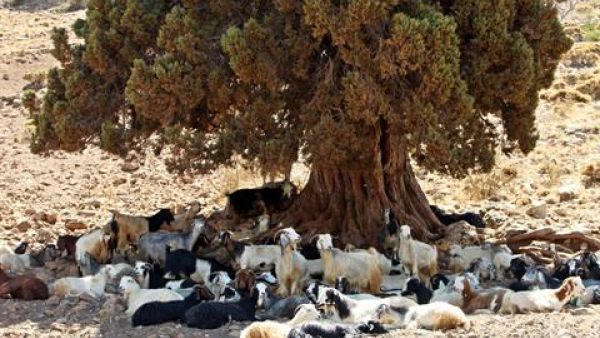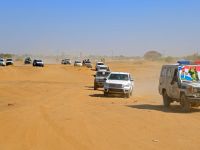In the cliffs high above the north Lebanon region of Dinnieh is a breathtaking view of the Mediterranean coast, from the bustling port of Tripoli all the way north to Tartous in Syria.
The limestone-studded cliffs are dotted with the nation’s iconic cedars, nestled alongside hundreds of its hardiest trees, the majestic junipers.
The soft curves of the juniper’s dark green leaf clusters accentuate their powerful, thick trunks. Some are centuries old, seemingly growing out of solid rock, and add an aura of quiet grit and determination to the solitude of the mountain.
But the junipers are in danger from encroaching agricultural activity, woodcutting and grazing.
“Human beings everywhere pose a danger to the environment if they don’t have awareness,” said Mohammad Taleb, a lawyer who has been working on turning one of the largest bastions of the junipers in Lebanon into a reserve.
Taleb, who visits the area regularly to escape the bustle of the city, said growing up in the countryside created an affinity for the greenery of the forest.
Local municipal authorities stand ready to turn the area into a protected reserve, but the decision still has to be approved by the Cabinet, which remains in a dysfunctional state.
But far away from Beirut’s politics, the entrance to the reserve high above Dinnieh is a marker of Lebanon’s history. The jagged road, if you could call it that, is known locally as the English Way, named after a massacre of the cedar and juniper trees that lined the area, cut down in the 1940s to build a railway between Lebanon and Syria.
Area residents cut down the junipers to use their wood to construct houses or as firewood, and to plant more functional fruit trees. Shepherds use the area as a grazing ground, contributing to the reduction of the juniper seedlings’ survival.
In a series of three scientific papers, Bouchra Douaihy, a lecturer at St. Joseph University, examined the status of the juniper population and its genetic diversity, characteristics and ecology.
Douaihy, who is from Ehden, the site of another nature reserve, said she carried out the study because no surveys of Lebanon’s junipers had been done, and because she admired the ability of the trees to live in such high altitudes.
“People admire this tree when they see it growing at such heights,” she said.
Junipers can often grow at heights of more than 2 kilometers above sea level, though they are more common between 1,400 and 1,800 meters.
Juniperus excelsa, known locally as Lezzeb, the species which grows in Lebanon, is found along the eastern Mediterranean basin in countries such as Greece, Turkey, Syria and Cyprus.
The tree’s hardiness is evident throughout its history. During late Tertiary and early Quaternary periods, as ice sheets smothered northern Europe, an ancestor of the modern juniper began a long migration south into warmer climates. Juniperus excelsa settled in the eastern Mediterranean, while its cousins established colonies in areas as diverse as Morocco, Spain, southern France, the Arabian Peninsula and East Africa.
Douaihy sampled populations throughout north Lebanon, including in Hermel, Akkar, Dinnieh, Barqa, Arsal and Afqa, marking out plots of land where the junipers grow and studying their genetic diversity and regeneration rates.
She also looked for signs of human disturbance – trees that were cut down, sites of grazing or agricultural activity.
To find out if the trees were reproducing enough, Douaihy scanned seeds produced by the trees, to try and discover the number of fertile ones produced by the adult junipers.
Conifers, which is the name given to the tree group that includes both junipers and cedars, have both male and female cones that carry the tree equivalent of spermatozoids and ovules.
Wind will carry the pollen from a male cone to a female one, sometimes on the same tree, where it grows and produces a seed deep inside the cone.
Though it is easier for male cone to fertilize a female one on the same tree, it is also the equivalent of human inbreeding, and can reduce genetic diversity, making the trees more vulnerable to threats and resulting in a higher number of empty seeds that cannot grow into new trees.
The Lebanese junipers appear not to be making enough babies.
On average, just 40 percent of the Lebanese trees have full seeds that can become adults, and at higher altitudes, the number is as low as 4 percent. The regeneration rate during the yearlong survey carried out by Douaihy was less than one – not enough to replace dying trees.
“Up there the trees are very big and very old and are in very hard environmental conditions,” Douaihy said. “And they are very scattered.”
Still, most junipers live to be hundreds of years old, and have time to reproduce. They continue to produce seeds until they die.
“If you preserve it, even if the regeneration rate is very low, the population can survive, because the juniper survives in really hard environmental conditions,” she said. “We can find it in the highest altitudes in Lebanon, where no other trees can survive.”
But if current trends continue without controlling agricultural activity around the junipers, they could become endangered.
“This makes the future of the juniper woodland in Lebanon largely uncertain,” according to a paper published by Douaihy and her colleagues in July.
The arguments for creating a reserve and protecting the junipers are numerous. The trees preserve the soil from erosion, and enrich it so other plants, animals and birds can survive in the unforgiving wilderness.
Their demise would also leave the high peaks of the north barren.
“If we lose it, no other tree can survive there,” Douaihy said.
But the exceptionalism of the determined junipers aside, their survival is a sign of the health of Lebanon’s wilderness, for the birth of a new tree is an intricate dance of nature.
Once a cone is fertilized and ready to germinate, it falls off the tree and could simply grow near the mother tree.
But thrushes eat the fleshy cones and digest them. The seeds pass intact through their digestive system, and may actually benefit from the acids in their stomachs. The birds then excrete the seeds elsewhere, where they grow into full trees.
But even the birds are endangered, their migration patterns disturbed by climate change and their numbers among Lebanon’s mountains thinned by hunters.
“They are all related in one ecosystem,” Douaihy said. “Any threat to one can affect the others.”








